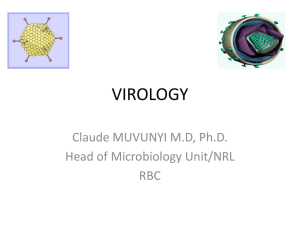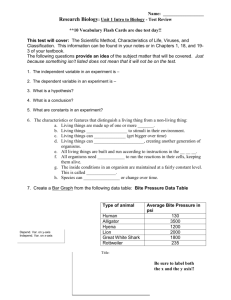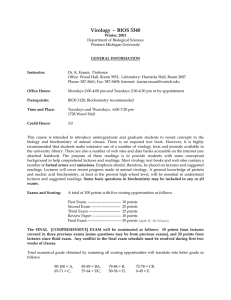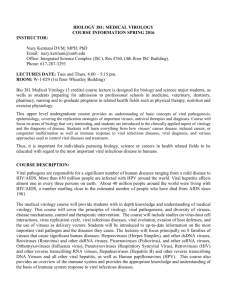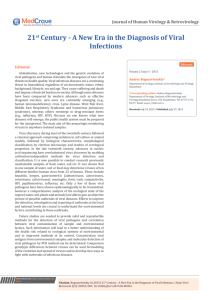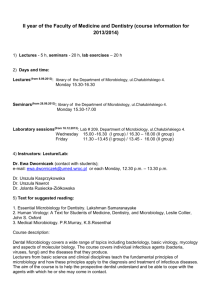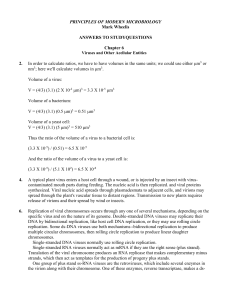Second Semester 2015
advertisement
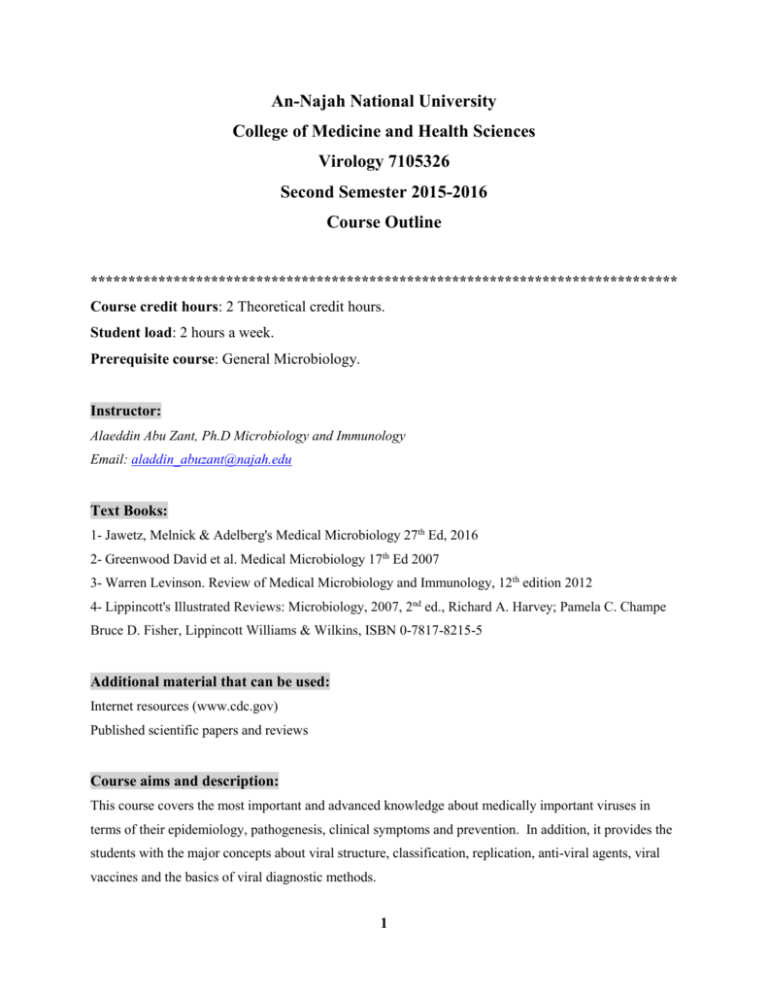
An-Najah National University College of Medicine and Health Sciences Virology 7105326 Second Semester 2015-2016 Course Outline ****************************************************************************** Course credit hours: 2 Theoretical credit hours. Student load: 2 hours a week. Prerequisite course: General Microbiology. Instructor: Alaeddin Abu Zant, Ph.D Microbiology and Immunology Email: aladdin_abuzant@najah.edu Text Books: 1- Jawetz, Melnick & Adelberg's Medical Microbiology 27th Ed, 2016 2- Greenwood David et al. Medical Microbiology 17th Ed 2007 3- Warren Levinson. Review of Medical Microbiology and Immunology, 12th edition 2012 4- Lippincott's Illustrated Reviews: Microbiology, 2007, 2nd ed., Richard A. Harvey; Pamela C. Champe Bruce D. Fisher, Lippincott Williams & Wilkins, ISBN 0-7817-8215-5 Additional material that can be used: Internet resources (www.cdc.gov) Published scientific papers and reviews Course aims and description: This course covers the most important and advanced knowledge about medically important viruses in terms of their epidemiology, pathogenesis, clinical symptoms and prevention. In addition, it provides the students with the major concepts about viral structure, classification, replication, anti-viral agents, viral vaccines and the basics of viral diagnostic methods. 1 Intended learning outcomes (ILOs) A- Knowledge and understanding: a.1- Recognize the basics of the science of virology a.2- Compare and contrast different virus families a.3- Describe the replication strategies of DNA and RNA viruses a.4- Explain the epidemiology and pathogenesis of viral diseases and the virus-host relationship a.5- Identify strategies to diagnose, prevent and combat human viral diseases a.6- Recognize and list human oncogenic viruses a.7- Identify non-conventional infectious agents and their pathogeneses B- Intellectual skills: b.1- Correlate between clinical features of eventual viral diseases. b.2- Choose and assess appropriate isolation methods and identification of different viruses. b.3- Discuss and evaluate viral application in medicine and biotechnology. b.4- Analyze critically research papers in Virology. C- General and transferable skills: c.1- Search Internet database for new updates in virology. c.2- Independent learning c.3- Work co-operatively in a team. c.4- Organize and present scientific data in oral and written manner using English language MAIN TOPICS OF THE COURSE I- INTRODUCTION TO VIROLOGY II- BASIC VIROLOGY Structure Replication Genetics Pathogenesis Classification Vaccines Antiviral agents 2 III-MEDICAL VIROLOGY A-DNA VIRUSES 1-Non-enveloped: Papovaviridae Adenoviridae Parvoviridae 2- Enveloped Herpesviridae Poxviridae Hepadnaviridae B-RNA VIRUSES SINGLE-STRANDED RNA VIRUSES 1-Single-stranded RNA viruses (Positive Polarity) A-Non-enveloped Picornaviridae Calciviridae Astroviridae B-Enveloped Togaviridae Flaviviridae Retroviridae Coronaviridae 2-Single-stranded RNA viruses (Negative Polarity) A-Enveloped Rhabdoviridae Paramyxoviridae Paramyxovirinae Pneumovirinae Orthomyxoviridae Filoviridae Bunyaviridae Arenaviridae DOUBLE-STRANDED RNA VIRUSES Reoviridae 3 C- Unconventional Infectious Agents Viroids Virusoids Prions Teaching and learning methods Tool Purpose Assessment method ILOS Lectures To explain the theoretical Written exams, a.1, a.2, a.3, a.4, a.5, a.6, knowledge for each topic. Homework, Quizzes. a.7. Tutorials and To explain the practical knowledge Objective testing, Documentary for each topic. Short answers, films c.1, c.2, c.3, c.4. Problem-solving. Case study and To answer the questions of the group discussion students and evaluates their Active participation. b.1, b.2, b.3, b.4 c.1, c.2, c.3, c.4. knowledge. Presentations To encourage students discuss, b.1, b.2, b.3, b.4 analyze and criticize data and Rubric evaluation. c.1, c.2, c.3, c.4. others works. Course Policies Class attendance (Participation) Case Presentation Grading Tool % Assessment Method ILOS First Exam 25 Second Exam 25 Objective essays question and a1-7, Final Exam 50 case study b1-4. Total 100 Rubric evaluation b1-4, Case study and - seminars c1-4. 4
